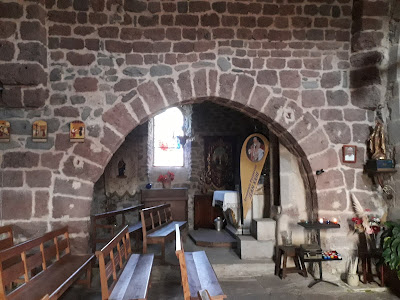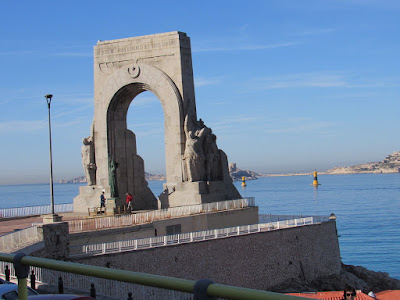
You enter the “cave” as any good speleogist would: gingerly, expectantly, curiously, and hopeful that you will discover a former presence, an ancient presence, an extremely ancient presence.
The first thing you see is a series of reddish palm prints that look like a kind of playful signature on the “rock.” Actually, it is a simple rendition of a bison. The cave discoverers’ first words were: “They were here,” they being early humans who used art to convey their ideas about the meaning of life and their reverence for the Earth and its creatures.
You press onward and see a bear skull set on top of a rock only it’s not just a skull, it is a skull deliberately placed on an altar. You begin to realize that you are not in just a “cave,” you are on holy ground, a sacred space.
As you penetrate the “cave” you see profile drawings in black charcoal or red ochre of a buffalo, a threesome of bears, a deer, a rhinoceros all leading up to the last panel where a crescendo of figures interact with each other. Some animals are grazing. Some are on the hunt. Some are just “being.” Indeed, “they were here,” too. And now, we are here connecting with them through art in a profound and visceral way on a journey dating back 35,000 years ago.
Bison
Lions on the hunt
Cave bear
Woolly Rhino

Hyena
Horses with small heads, brush-like manes, and small eyes
Auroch
Actually, we are in a replica of Grotte Chauvet built for the public so that they could experience a representation of the original cave. Grotte Chauvet 2 provides a profoundly mystical experience of
imagination, creativity, and spirituality of the Aurignacians, hunter-gatherers who lived during the Ice Age in
southwestern Europe between 36,000 to 12,000 years ago.
Grotte Chauvet 2 stands like a monolith as in the film, 2001: A Space Odyssey like something from the past and something of the present. And in a way, Grotte Chauvet 2 is just that, thanks to modern technology and a devoted team of artists, engineers, and scientists who re-created what the Aurignacian artists did 35,000 years ago.


This 5-minute BBC video provides background on the cave and shows how Grotte Chauvet 2 was constructed.
This Euromaxs video also shows how the "cave" was constructed. It provides interviews of visitors and locals.
This work took thousands of hours and more than 500 people from 35 companies. Planners selected the most interesting and spectacular paintings—22 panels with 142 figures out of 1,000+ paintings found in the cave with a surface space of 32,300 square feet compared to 91,500 square feet in the original cave.
Modern artists reproduced the cave paintings with the colors and materials similar to those of the original artists paying attention to the variations of black, grey, and red markings of the drawings. They used wood charcoal to “rediscover both the power and the fragility of the curves that formed the animal figures drawn in charcoal or smudged by stump work.
A team of nine sculptors, painters, and artists from Montignac in the Dordogne region worked on the cave drawings in an atmosphere of “studious contemplation” to reproduce within a millimeter, the decorated walls of the cave.
Again, accuracy was of paramount concern. Even the fossil shells embedded in the original limestone cave walls as well as bear claw marks were reproduced. Copyists then added color to the “wall” to represent the minerals of the rock.
 One team constructed
the walls, floors, and ceilings of the cave with concrete and resin. They used a process called
"anamorphosis" where they scanned the richest parts of the cave in terms
of paleontology and geology and created a 3-D digital map.
One team constructed
the walls, floors, and ceilings of the cave with concrete and resin. They used a process called
"anamorphosis" where they scanned the richest parts of the cave in terms
of paleontology and geology and created a 3-D digital map.
Visual artists in Paris took resin and formed
speleothems (secondary mineral deposits formed
in caves by flowing, dripping, ponded, or seeping water) in order to create 110 stalagmites, stalactites,
gours, large concretions, pendants, and soda straws as shown here.



stalagmites gour
columns (left) and pendant (right)
concretions
soda straw

stalgatites
Although the walls, floors, and formations were scientifically studied, recreating them became an interesting process of "transmitting" knowledge and understanding about geology and history from the geologists to the sculptors, said Jean-Jacques Delannoy. For example, the sculptors went with geologists to see real caves and to learn about their geological history. This "transmission process" greatly aided in enhancing the authenticity in the Grotte replica.
The sculptors also came to realize that geology wasn't a fixed, stable thing, said Delannoy, but rather a living element that changes over time. Stalagmites, stalagtites, and crystals, for example, grow and agglomerate. Different levels of materials "formulate," that is, they create concretions, develop color, sparkle, change transparency, and respond to light.
Consequently, to make the materials for the "cave", the artists produced micron casts and built a "speleothem library" that served as a tool for reproducing the various cave formations. Their objective was to remain both scientifically truthful and emotionally charged.
Sculptors and polishers gave the "stone" (made of concrete and resin) a finishing touch with their trowels, brushes, and styluses. Not only was this work done by the centimeter, but cracks and crevices were dug into the “rock” and white, red, or black fluids and pigments (representing calcite, iron oxide, and manganese respectively) were added in order to reproduce the original appearance of the rock. An inspector with an iPad compared the image of the wall with the 3-D model—about 3 square meters per day—to assure authenticity to the real cave.
 Another team “hung” the cave with from the ceiling of
the concrete shell of the building. With thousands of twisted metal rods, the
workers matched the digital coordinates of their 3-D model. More than 100 kilometers
of metal rods were bent and welded together to produce “cages” for the vaults
and walls. Workers then projected two layers of stone-colored mortar onto the
“cages.” About 1,200 tons of steel, resin, cement, and concrete were used.
Another team “hung” the cave with from the ceiling of
the concrete shell of the building. With thousands of twisted metal rods, the
workers matched the digital coordinates of their 3-D model. More than 100 kilometers
of metal rods were bent and welded together to produce “cages” for the vaults
and walls. Workers then projected two layers of stone-colored mortar onto the
“cages.” About 1,200 tons of steel, resin, cement, and concrete were used.
Scenographers orchestrated the design and construction of the cave and the staging of the space.
“We needed to define what seemed credible, what the cave’s spirit and its soul were,” said Mélanie Claude and Jean-Hugues Manoury.
They reflected on the dynamics and spontaneity of the Aurignacians rather than to just copy their artwork, which they believed might turn out to be “sterile immobility.” They then reflected on the qualities of the cave that made it the place it was: intimate, silent, dark, shadowy, cool, humid. Specialists were called upon to reproduce these effects as well as sound, acoustics, smell, and humidity. Lighting was subtle in order to contrast in rendering color, sparkle, and texture to the rock, according to scenographers Mélanie Claude and Jean-Hugues Manoury.
The artwork was executed with precision and sensitivity to convey the emotional quality of the paintings. For example, one artist burned pine branches to reproduce the charcoal the Aurignacians used for outlining their figures. He then applied his learning after long sessions of scientific analysis of the original cave with its layered and complex lines on the walls.
Grotte Chauvet 2 is truly a work of art within a work of art and its effect on visitors emits a profound emotional response.
Jean Clottes, a specialist in cave art, was the first professional to visit the original cave after its discovery in December 1994. He authenticated the drawings and served as director of
the scientific team that initially studied the cave for four years. He remarked on Grotte Chauvet 2:
“I have just felt an emotion comparable to the one I experienced twenty years ago before the original and that was among the most intense in my life as a man and as a researcher….This is a great achievement, up to the task of sharing with the public the treasure of humankind that is the painted Chauvet-Pont d’Arc cave.”
My own response to Grotte Chauvet 2 was to wonder more deeply about what I was seeing and my profound reaction to it. At one point, I was moved to draw the animal figures of the “cave” and that effect, too, took me to another plane that induced both reverence and awe in the art. (Click here for a blog about the spiritual side of the cave.)
Grotte Chauvet was such an awe-inspiring experience, it took me three months to get up the courage to write about it because I knew I was impinging on holy ground, even though it was only a replica. I did more research on Grotte Chauvet and the Paleolithic era in general in order to reflect and understand it better. I have found a new interest!
Sources
Claude Pommereau, ed. Grotte Chauvet 2--Ardèche. Beaux Arts and Cie Éditions, Paris.
Grotte Chauvet 2
https://en.grottechauvet2ardeche.com/
France creates replica Chauvet cave for spectacular prehistoric art--Newsnight https://www.youtube.com/watch?v=Q2ycvQ80MdA
The Bradshaw Foundation
http://www.bradshawfoundation.com/chauvet/index.php
Photos of the drawings
https://images.app.goo.gl/yseQMhcahpK1CRxU6


































